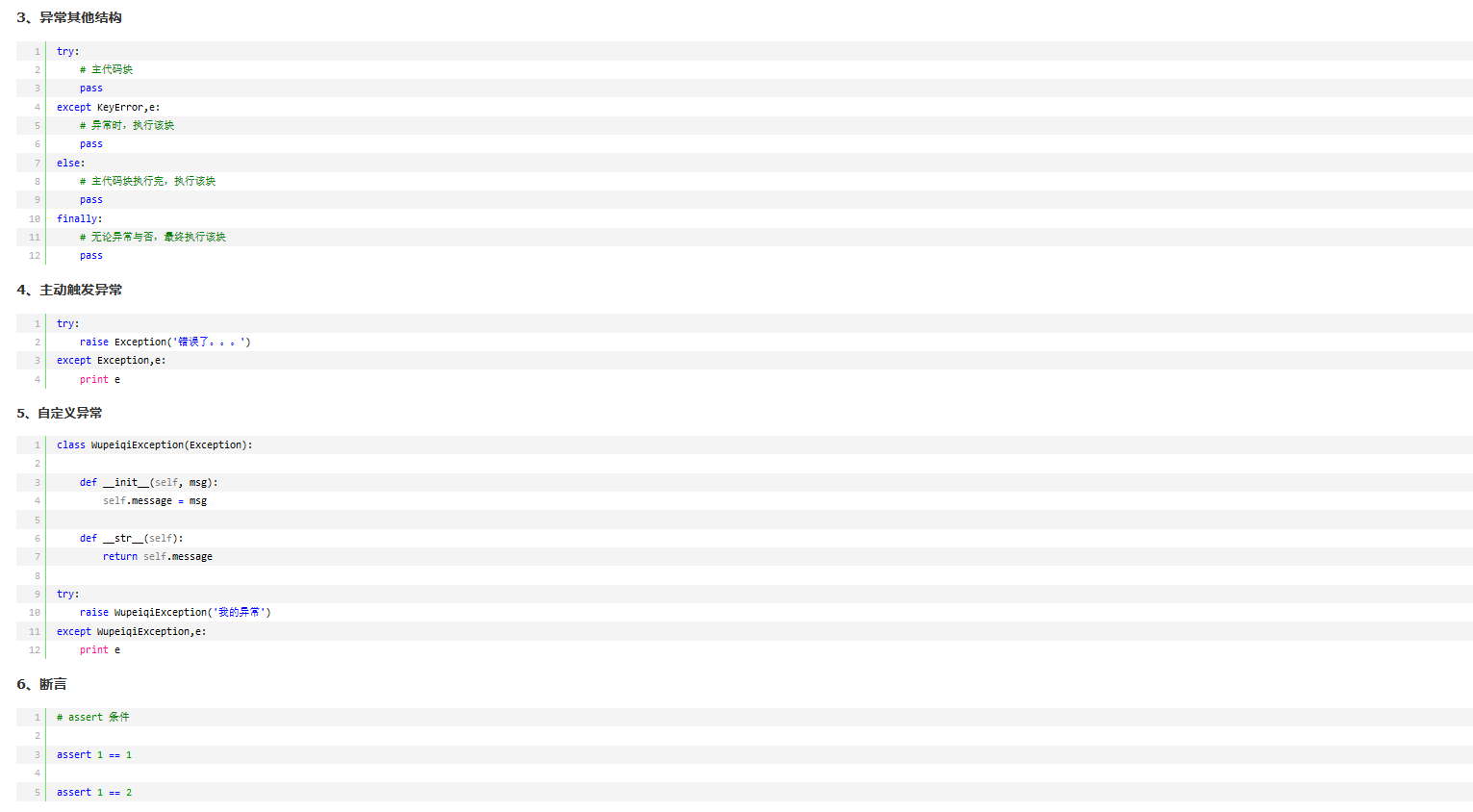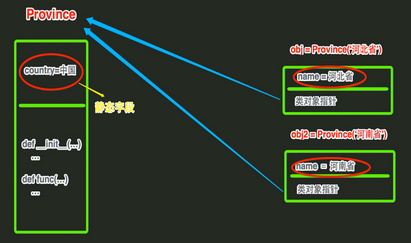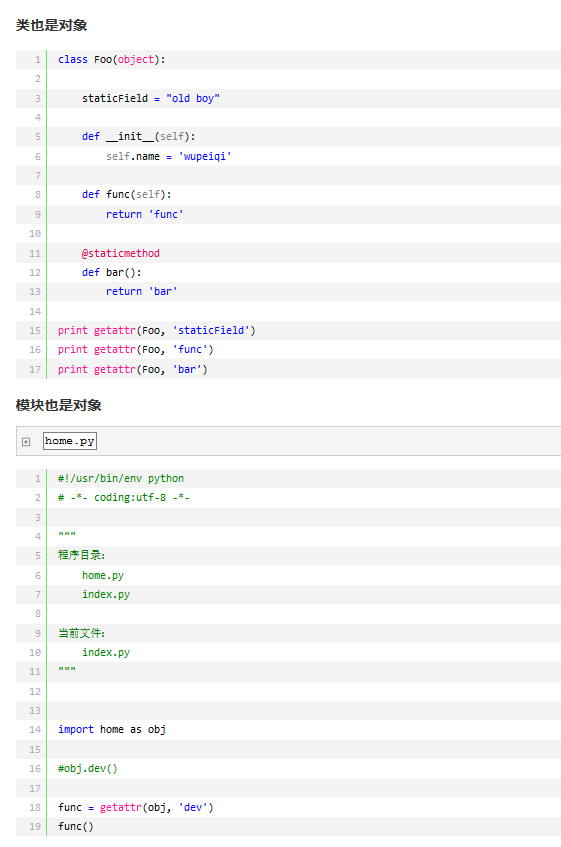其他相关
一、isinstance(obj, cls)
检查是否obj是否是类 cls 的对象
1 class Foo(object): 2 pass 3 4 obj = Foo() 5 6 isinstance(obj, Foo)
二、issubclass(sub, super)
检查sub类是否是 super 类的派生类
1 class Foo(object): 2 pass 3 4 class Bar(Foo): 5 pass 6 7 issubclass(Bar, Foo)
三、异常处理
1、异常基础
在编程过程中为了增加友好性,在程序出现bug时一般不会将错误信息显示给用户,而是现实一个提示的页面,通俗来说就是不让用户看见大黄页!!!
1 try: 2 pass 3 except Exception,ex: 4 pass
需求:将用户输入的两个数字相加

1 while True: 2 num1 = raw_input('num1:') 3 num2 = raw_input('num2:') 4 try: 5 num1 = int(num1) 6 num2 = int(num2) 7 result = num1 + num2 8 except Exception, e: 9 print '出现异常,信息如下:' 10 print e
2、异常种类
python中的异常种类非常多,每个异常专门用于处理某一项异常!!!
万能异常 在python的异常中,有一个万能异常:Exception,他可以捕获任意异常
接下来你可能要问了,既然有这个万能异常,其他异常是不是就可以忽略了!
答:当然不是,对于特殊处理或提醒的异常需要先定义,最后定义Exception来确保程序正常运行。
1 s1 = 'hello' 2 try: 3 int(s1) 4 except KeyError,e: 5 print '键错误' 6 except IndexError,e: 7 print '索引错误' 8 except Exception, e: 9 print '错误'

四、反射
python中的反射功能是由以下四个内置函数提供:hasattr、getattr、setattr、delattr,改四个函数分别用于对对象内部执行:检查是否含有某成员、获取成员、设置成员、删除成员。
反射:根据字符串形式去某个模块中寻找东西getattr
根据字符串形式去某个模块中判断东西是否存在hasattr
setattr 去某个模块设置东西,包括变量、函数
delattr 内存中删除 不影响原文件 上面模块也是对象

1 class Foo(object): 2 3 def __init__(self): 4 self.name = 'wupeiqi' 5 6 def func(self): 7 return 'func' 8 9 obj = Foo() 10 11 # #### 检查是否含有成员 #### 12 hasattr(obj, 'name') 13 hasattr(obj, 'func') 14 15 # #### 获取成员 #### 16 getattr(obj, 'name') 17 getattr(obj, 'func') 18 19 # #### 设置成员 #### 20 setattr(obj, 'age', 18) 21 setattr(obj, 'show', lambda num: num + 1) 22 23 # #### 删除成员 #### 24 delattr(obj, 'name') 25 delattr(obj, 'func')
详细解析:
当我们要访问一个对象的成员时,应该是这样操作:
1 class Foo(object): 2 3 def __init__(self): 4 self.name = 'alex' 5 6 def func(self): 7 return 'func' 8 9 obj = Foo() 10 11 # 访问字段 12 obj.name 13 # 执行方法 14 obj.func()
那么问题来了?a、上述访问对象成员的 name 和 func 是什么?答:是变量名b、obj.xxx 是什么意思?答:obj.xxx 表示去obj中或类中寻找变量名 xxx,并获取对应内存地址中的内容。c、需求:请使用其他方式获取obj对象中的name变量指向内存中的值 “alex”class Foo(object): def __init__(self): self.name = 'alex' # 不允许使用 obj.name obj = Foo()答:有两种方式,如下:
class Foo(object): def __init__(self): self.name = 'alex' def func(self): return 'func' # 不允许使用 obj.name obj = Foo() print obj.__dict__['name'] 方式一class Foo(object): def __init__(self): self.name = 'alex' def func(self): return 'func' # 不允许使用 obj.name obj = Foo() print getattr(obj, 'name') 方式二d、比较三种访问方式
- obj.name
- obj.__dict__['name']
- getattr(obj, 'name')
答:第一种和其他种比,...
第二种和第三种比,... web框架实例1 #!/usr/bin/env python 2 #coding:utf-8 3 from wsgiref.simple_server import make_server 4 5 class Handler(object): 6 7 def index(self): 8 return 'index' 9 10 def news(self): 11 return 'news' 12 13 14 def RunServer(environ, start_response): 15 start_response('200 OK', [('Content-Type', 'text/html')]) 16 url = environ['PATH_INFO'] 17 temp = url.split('/')[1] 18 obj = Handler() 19 is_exist = hasattr(obj, temp) 20 if is_exist: 21 func = getattr(obj, temp) 22 ret = func() 23 return ret 24 else: 25 return '404 not found' 26 27 if __name__ == '__main__': 28 httpd = make_server('', 8001, RunServer) 29 print "Serving HTTP on port 8000..." 30 httpd.serve_forever() 31 32 Web框架实例
web框架实例1 #!/usr/bin/env python 2 #coding:utf-8 3 from wsgiref.simple_server import make_server 4 5 class Handler(object): 6 7 def index(self): 8 return 'index' 9 10 def news(self): 11 return 'news' 12 13 14 def RunServer(environ, start_response): 15 start_response('200 OK', [('Content-Type', 'text/html')]) 16 url = environ['PATH_INFO'] 17 temp = url.split('/')[1] 18 obj = Handler() 19 is_exist = hasattr(obj, temp) 20 if is_exist: 21 func = getattr(obj, temp) 22 ret = func() 23 return ret 24 else: 25 return '404 not found' 26 27 if __name__ == '__main__': 28 httpd = make_server('', 8001, RunServer) 29 print "Serving HTTP on port 8000..." 30 httpd.serve_forever() 31 32 Web框架实例结论:反射是通过字符串的形式操作对象相关的成员。一切事物都是对象!!!
 View Code#!/usr/bin/env python # -*- coding:utf-8 -*- import sys def s1(): print 's1' def s2(): print 's2' this_module = sys.modules[__name__] hasattr(this_module, 's1') getattr(this_module, 's2') 反射当前模块成员
View Code#!/usr/bin/env python # -*- coding:utf-8 -*- import sys def s1(): print 's1' def s2(): print 's2' this_module = sys.modules[__name__] hasattr(this_module, 's1') getattr(this_module, 's2') 反射当前模块成员
设计模式
一、单例模式
单例,顾名思义单个实例。
学习单例之前,首先来回顾下面向对象的内容:
python的面向对象由两个非常重要的两个“东西”组成:类、实例
面向对象场景一:
如:创建三个游戏人物,分别是:
- 苍井井,女,18,初始战斗力1000
- 东尼木木,男,20,初始战斗力1800
- 波多多,女,19,初始战斗力2500
# ##################### 定义类 ##################### class Person: def __init__(self, na, gen, age, fig): self.name = na self.gender = gen self.age = age self.fight =fig def grassland(self): """注释:草丛战斗,消耗200战斗力""" self.fight = self.fight - 200 # ##################### 创建实例 ##################### cang = Person('苍井井', '女', 18, 1000) # 创建苍井井角色 dong = Person('东尼木木', '男', 20, 1800) # 创建东尼木木角色 bo = Person('波多多', '女', 19, 2500) # 创建波多多角色面向对象场景二:
如:创建对数据库操作的公共类
- 增
- 删
- 改
- 查
# #### 定义类 #### class DbHelper(object): def __init__(self): self.hostname = '1.1.1.1' self.port = 3306 self.password = 'pwd' self.username = 'root' def fetch(self): # 连接数据库 # 拼接sql语句 # 操作 pass def create(self): # 连接数据库 # 拼接sql语句 # 操作 pass def remove(self): # 连接数据库 # 拼接sql语句 # 操作 pass def modify(self): # 连接数据库 # 拼接sql语句 # 操作 pass # #### 操作类 #### db = DbHelper() db.create()
实例:结合场景二实现Web应用程序

1 #!/usr/bin/env python 2 #coding:utf-8 3 from wsgiref.simple_server import make_server 4 5 6 class DbHelper(object): 7 8 def __init__(self): 9 self.hostname = '1.1.1.1' 10 self.port = 3306 11 self.password = 'pwd' 12 self.username = 'root' 13 14 def fetch(self): 15 # 连接数据库 16 # 拼接sql语句 17 # 操作 18 return 'fetch' 19 20 def create(self): 21 # 连接数据库 22 # 拼接sql语句 23 # 操作 24 return 'create' 25 26 def remove(self): 27 # 连接数据库 28 # 拼接sql语句 29 # 操作 30 return 'remove' 31 32 def modify(self): 33 # 连接数据库 34 # 拼接sql语句 35 # 操作 36 return 'modify' 37 38 39 class Handler(object): 40 41 def index(self): 42 # 创建对象 43 db = DbHelper() 44 db.fetch() 45 return 'index' 46 47 def news(self): 48 return 'news' 49 50 51 def RunServer(environ, start_response): 52 start_response('200 OK', [('Content-Type', 'text/html')]) 53 url = environ['PATH_INFO'] 54 temp = url.split('/')[1] 55 obj = Handler() 56 is_exist = hasattr(obj, temp) 57 if is_exist: 58 func = getattr(obj, temp) 59 ret = func() 60 return ret 61 else: 62 return '404 not found' 63 64 if __name__ == '__main__': 65 httpd = make_server('', 8001, RunServer) 66 print "Serving HTTP on port 8001..." 67 httpd.serve_forever() 68 69 Web应用程序实例
对于上述实例,每个请求到来,都需要在内存里创建一个实例,再通过该实例执行指定的方法。
那么问题来了...如果并发量大的话,内存里就会存在非常多功能上一模一样的对象。存在这些对象肯定会消耗内存,对于这些功能相同的对象可以在内存中仅创建一个,需要时都去调用,也是极好的!!!
铛铛 铛铛 铛铛铛铛铛,单例模式出马,单例模式用来保证内存中仅存在一个实例!!!
通过面向对象的特性,构造出单例模式:
# ########### 单例类定义 ########### class Foo(object): __instance = None @staticmethod def singleton(): if Foo.__instance: return Foo.__instance else: Foo.__instance = Foo() return Foo.__instance # ########### 获取实例 ########### obj = Foo.singleton()
对于Python单例模式,创建对象时不能再直接使用:obj = Foo(),而应该调用特殊的方法:obj = Foo.singleton() 。

1 #!/usr/bin/env python 2 #coding:utf-8 3 from wsgiref.simple_server import make_server 4 5 # ########### 单例类定义 ########### 6 class DbHelper(object): 7 8 __instance = None 9 10 def __init__(self): 11 self.hostname = '1.1.1.1' 12 self.port = 3306 13 self.password = 'pwd' 14 self.username = 'root' 15 16 @staticmethod 17 def singleton(): 18 if DbHelper.__instance: 19 return DbHelper.__instance 20 else: 21 DbHelper.__instance = DbHelper() 22 return DbHelper.__instance 23 24 def fetch(self): 25 # 连接数据库 26 # 拼接sql语句 27 # 操作 28 pass 29 30 def create(self): 31 # 连接数据库 32 # 拼接sql语句 33 # 操作 34 pass 35 36 def remove(self): 37 # 连接数据库 38 # 拼接sql语句 39 # 操作 40 pass 41 42 def modify(self): 43 # 连接数据库 44 # 拼接sql语句 45 # 操作 46 pass 47 48 49 class Handler(object): 50 51 def index(self): 52 obj = DbHelper.singleton() 53 print id(single) 54 obj.create() 55 return 'index' 56 57 def news(self): 58 return 'news' 59 60 61 def RunServer(environ, start_response): 62 start_response('200 OK', [('Content-Type', 'text/html')]) 63 url = environ['PATH_INFO'] 64 temp = url.split('/')[1] 65 obj = Handler() 66 is_exist = hasattr(obj, temp) 67 if is_exist: 68 func = getattr(obj, temp) 69 ret = func() 70 return ret 71 else: 72 return '404 not found' 73 74 if __name__ == '__main__': 75 httpd = make_server('', 8001, RunServer) 76 print "Serving HTTP on port 8001..." 77 httpd.serve_forever() 78 79 Web应用实例-单例模式
总结:单利模式存在的目的是保证当前内存中仅存在单个实例,避免内存浪费!!!


